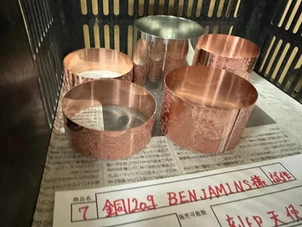

TAKAHIRO YAGI
Japan
TEA CADDY MAKER
Kaikado was established in 1875 by Seisuke, creator of the first Kaikado tin tea caddy, appreciated for its style and functional, airtight design. The current successor, Takahiro, developed a two-tiered tea caddy, initiated the first-ever collaborations with tea brands and started marketing the caddies abroad. Whilst always maintaining tradition, Takahiro set his sights on the global market. Adding a new element per generation is a tradition that Kaikado has carried on throughout its history.
Info from website:
In 1875, during the Meiji Restoration, Kaikado was founded in Kyoto as a pioneer in the manufacture of round cans, using tinplate that had been imported from the U.K. Since then, we have continued to make our products by hand, preserving the methods used by our founder for over a century.Why have we been able to continue making tea caddies for over a century? It is because we understand that the most important thing is to know, protect, and continue making the value of the tea caddies created by our founder. This has been passed down from generation to generation even as times and circumstances have changed.During World War II, when the metal collection order was issued, the family made tea canisters in secret, burying their tools in the ground to protect them. However, the third generation was even imprisoned for this. After the war, Japan entered a period of rapid economic growth, and foreign-made industrial products became popular. Although machine-made products were considered better than handmade products, the family did not switch to machine manufacturing. However, the situation was tough, and in order to make a living, they continued to make tea canisters on the side while running a pharmacy.Thanks to the support of many shops, I was able to overcome those times and finally return to making tea canisters full-time, and even had the opportunity to present one to the Emperor. However, it was a time when it was difficult to sell tea canisters unless I expanded my sales area beyond Kyoto to the Sanin region west of Nagoya and the Setouchi region.The times have entered an era of mass production and mass consumption, and while large-scale transactions have increased, sales have risen, but productivity has also been demanded. However, they continued to make tea canisters by hand. This is because mass production by machine inevitably leads to a decline in quality and the tea canisters are no longer Kaikado's. In the meantime, the economy has been on a downward trend due to the effects of the collapse of the bubble economy, and they have been forced to repeatedly reduce prices, which has led to difficult times. Around this time, the fifth generation owner was considering giving up making tea canisters in his generation. Around that time, the sixth generation owner saw overseas travelers buying Kaikado tea canisters, and felt that there was value in tea canisters after all. In order to change the situation, he reviewed his sales method, which had been limited to wholesale, opened a store for general customers, and began to hold live demonstration sales both in Japan and overseas, and began to receive orders from many people. This was possible because he had continued making tea canisters without giving up.Even if a Kaikado tea canister gets dented or warped, it can be repaired and used for a long time. This is possible because it is handmade. We are very fortunate to have customers who have been using our tea canisters for two or even three generations. Of course, this is because our customers have taken good care of them, but we will continue to pass on our techniques so that if repairs become necessary in the future, our craftsmen will be able to repair them.Kaikado will continue to provide you with everyday tools that can be used for 100 years.




